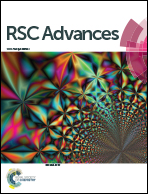Magnetic copper ferrite nanoparticles/TEMPO catalyzed selective oxidation of activated alcohols to aldehydes under ligand- and base-free conditions in water†
Abstract
A novel, effective and sustainable strategy for the synthesis of aldehydes has been developed using inexpensive, readily available, oxygen-stable and recyclable CuFe2O4 nanoparticles as the catalyst. The corresponding substituted aldehydes were obtained in moderate to good yields by aerobic oxidation of aromatic alcohols in water under dioxygen atmosphere. Importantly, a ligand or a base was not necessary. The catalyst was completely recoverable with an external magnet and could be reused six times without significant loss of catalytic activity.


 Please wait while we load your content...
Please wait while we load your content...